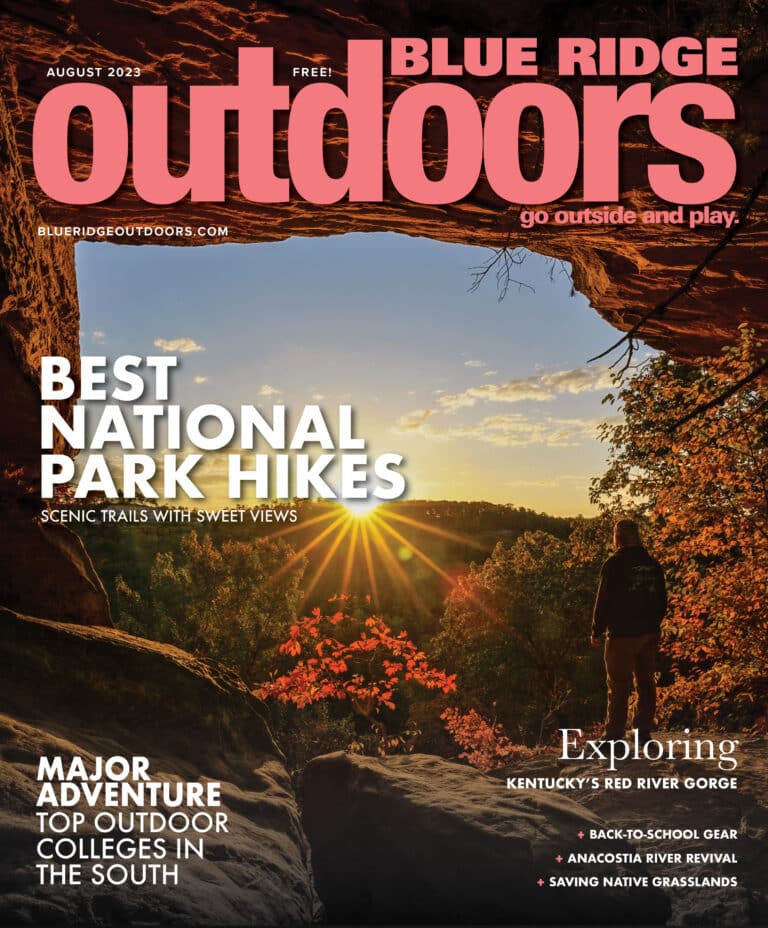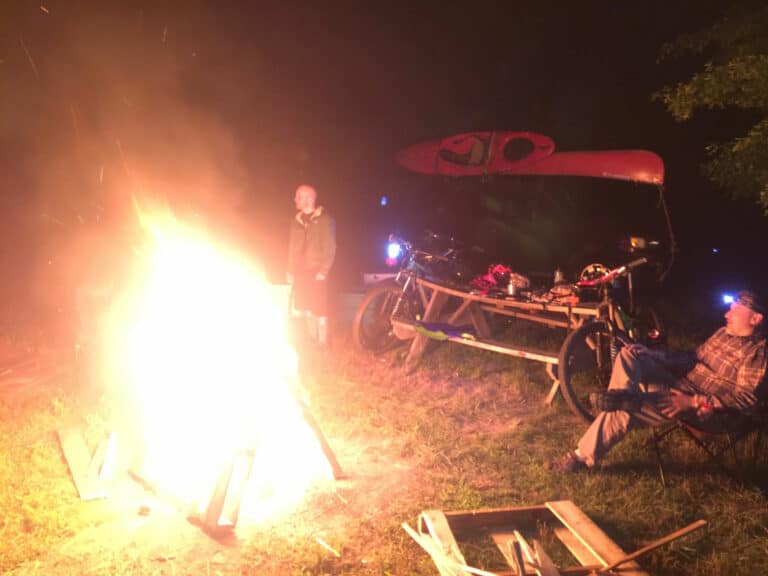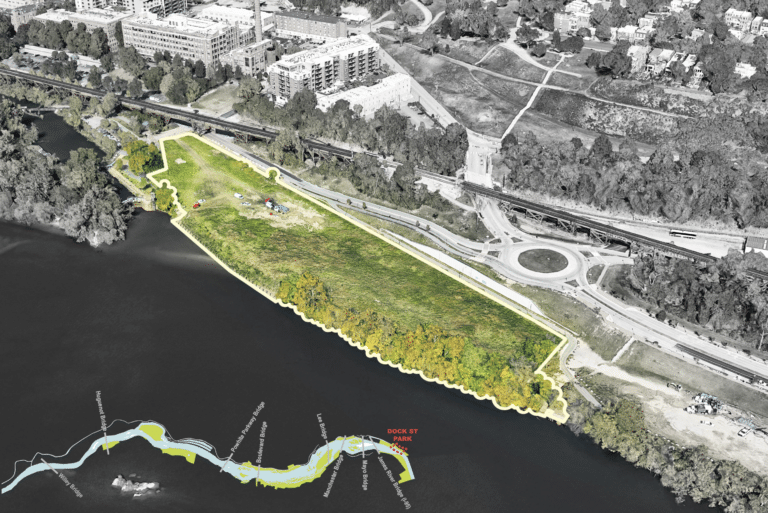In hindsight, the can of smoked oysters was probably a bad idea. I didn’t plan on eating all of them. I just wanted a few—a savory snack to bring me comfort during the low point of the day. Every big adventure has a moment when you regret all the decisions you’ve made in your life and you wish you were back home, sitting on a couch, eating a snack with your feet up. I’ve found that having a few delicious canned oysters brings me a level of comfort that standard trail mix just can’t deliver. I figured we’d all need the comfort during our “run” of the brutal Black Mountain Crest Trail (BMCT), a gem of a footpath that follows the ridgeline of the tallest mountains east of the Mississippi. I thought the oysters would be the key to a successful day, but my cohorts declined when I offered to share, so it was up to me to eat the whole tin. A few miles later, I can feel every little bivalve sitting heavy in my stomach as I try to “run” along the edge of 6,596-foot Balsam Cone. Turns out canned oysters aren’t the key to success on a “run” like this. Apparently, being in better shape is the key to success.
Notice I’m putting “running” in quotation marks. There isn’t much running involved in our adventure. The BMCT is 12 miles of mostly ridgeline singletrack that climbs an insane amount of elevation on its way to the edge of Mount Mitchell. Most of the trail sits at 6,000 feet above sea level, and the tread is rocky and steep with some sections that require fixed ropes for climbing and descending. Most people tackle it as a tough two-day point to point, setting up a shuttle and taking their time. I hate shuttles and I don’t have time for an overnight adventure, so we decide to try it as a 24-mile single-day out and back. The BMCT is difficult with a shuttle, but this way it’s borderline suicidal. But that’s kind of what we’re going for here.
The idea was to get out of our comfort zone and spend a single day doing something really hard, like “leave an emotional scar” hard. The BMCT fits the bill. The thing starts with a 3,000-foot climb in the first four miles. And that’s just an appetizer. From there, the real work begins as you’re ascending and descending several 6,000-foot peaks, climbing hand over hand up stretches of boulders. Put it all together and you’ll cover 24 miles with 8,000 feet of gain at the highest elevations in the eastern U.S. As an adventure, it has a nice ring to it, in a painful, “what the hell are you thinking?” sort of way. I spend most of my life avoiding hard work of any kind, but it’s important to push yourself every once in a while.
It’s also possible that I feel like I have something to prove. Coronavirus kept me out of the gym for a year and a series of nagging injuries slowed my running down at the same time. I’m feeling soft and particularly mortal. You could argue that tackling the Black Mountain Crest as an out and back is a desperate attempt to prove to myself that I can still do big adventures on a whim. I convinced two friends to come with me because quixotic adventures and tins of oysters are made for sharing.
We’re jovial on the initial climb from the bottom of Bowlens Creek and one of my running partners tells us how his father-in-law climbed Kilimanjaro recently in his late 60s. It was on the man’s bucket list for most of his adult life and he finally decided to go for it when he retired. He reached the summit, which is great, but then he had to be carried down by his Sherpas because he was so exhausted, which is less great.
I spend the next few miles trying to figure out how you’d carry a man down a mountain. Like, over the shoulder, fireman’s carry? Or that weird Finnish Wife Carry where the person is inverted and backwards? Turns out it took two Sherpas—one grabbing his feet, the other taking his shoulders. We all look at each other and try to figure out which one of us will need to be carried off the ridge, Kilimanjaro style, at the end of this adventure. It’s funny until my knees start to ache and I think a piggy back ride might not be so bad. The pain in my knees makes me think I’ve gotten in over my head, and every time I get in over my head, I think about the Boy Scouts.
Let me explain.
When I was 22, I decided to hike to the bottom of the Grand Canyon and back up to the top in a single day. It’s a tough effort but so tantalizing that a lot of people try it, fail, and need a rescue. So, there’s a troop of pudgy Boy Scouts who volunteer to stand at the top of the trail along the rim and discourage hikers from even setting foot on the trail. They look you over and tell you that you don’t have what it takes. You’re not fit enough. You don’t have enough water and food. You should’ve trained more. Wouldn’t you be happier just admiring the view from the comfort of your air-conditioned car on one of the many road-side pull offs? The Boy Scouts were right; climbing out of that canyon almost killed me.
I should hire that troop of Boy Scouts to follow me around all the time, shaking me down and second guessing every poor decision I make. They would’ve save me a lot of trouble and medical bills. I definitely could’ve used their skepticism at the trailhead for the BMCT. It gets to the point where I’m crab-walking down some of the steep, boulder-laden downhills trying to take some pressure off my knees.
We never make it to Mitchell. It’s not my knees that stop us, but the lack of daylight. We get damn close, turning back about a mile shy of the parking lot. I’m a little disappointed, but this adventure was never about summitting. It was about spending the day in the mountains doing hard things. Turning around short of the summit still gives us a 22-mile out and back with 8,000 feet of climbing along the top of our corner of the world. It’s not the hardest thing I’ve ever done, but it’s hard, especially the last four miles, which is straight back down to Bowlens Creek. We take a comically slow pace, inventing switchbacks where there are none because we’re so fatigued. My knees feel like they’re going to shatter, but nobody has to carry me by the ankles and shoulders down the mountain, so I’m going to chalk that up as a victory. As far as I’m concerned, that means I’ve still got it. And Boy Scouts be damned, I regret nothing. Not even the oysters.
Cover photo: The rugged Black Mountain Crest Trail mostly runs on ridgeline singletrack and gains significant elevation on the way to Mount Mitchell. Photo courtesy of the author








